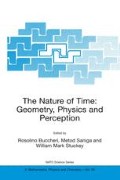Abstract
The present paper is intended to discuss how to develop the statistical approach proposed in [1, 2]. According to the relational (or relative) principle, the properties of a model clock represent the properties of physical time. (This relational view goes back to physicists and philosophers such as Leibniz, Mach, Einstein, Poincare, and others) To construct a model of physical time implies constructing a model instrument for its measurement, namely, a clock. In the postulated basic equation, the increment of time is expressed through the average value of increments of spatial coordinates of particles of the system under consideration, and time and space are closely connected. The relationships correspond to conservation laws, and the standard motion equations are derived from this basic correspondence.
Access this chapter
Tax calculation will be finalised at checkout
Purchases are for personal use only
Preview
Unable to display preview. Download preview PDF.
References
Aristov, V.V. (1994) Statistical model of clocks in a physical theory, Physics-Doklady (Doklady of the Russian Academy of Sciences) 39, 45–48.
Aristov, V.V. (1995) Relative statistical model of clocks and physical properties of time, in A.P. Levich (ed.), On the Way to Understanding the Time Phenomenon: the Constructions of Time in Natural Science, World Scientific, Singapore, pp. 26–45.
Hawking, S.W. (1978) Spacetime foam, Nuclear Physics B144, 349–362.
Aristov, V.V. (1999) Statistical mechanics and a model for description of spacetime, Communications in Applied Mathematics, Computing Center of the Russian Academy of Sciences, Moscow (in Russian).
Berge, C. (1971) Principles of Combinatorics, Academic Press, New York and London.
Kittel, C. (1973) Thermal Physics, Wiley, New York.
Nelson, E. (1995) Quantum Fluctuations, Princeton University Press, Princeton.
Ord, G.N. (1996) Fractal spacetime and the statistical mechanics of random walks, Chaos, Solitons and Fractals 7, 821–843.
Eddington, A. (1949) Fundamental Theory, Cambridge University Press, Cambridge.
Kafatos, M., Roy, S., and Amoroso, R.L. (2000) Scaling in cosmology and the arrow of time, in R. Buccheri, V. Di Gesù and M. Saniga (eds.), Studies on the Structure of Time: From Physics to Psycho(patho)logy, Kluwer Academic / Plenum Publishers, New York, pp. 191–200.
Author information
Authors and Affiliations
Editor information
Editors and Affiliations
Rights and permissions
Copyright information
© 2003 Springer Science+Business Media Dordrecht
About this chapter
Cite this chapter
Aristov, V.V. (2003). On the Relational Statistical Space-Time Concept. In: Buccheri, R., Saniga, M., Stuckey, W.M. (eds) The Nature of Time: Geometry, Physics and Perception. NATO Science Series, vol 95. Springer, Dordrecht. https://doi.org/10.1007/978-94-010-0155-7_22
Download citation
DOI: https://doi.org/10.1007/978-94-010-0155-7_22
Publisher Name: Springer, Dordrecht
Print ISBN: 978-1-4020-1201-3
Online ISBN: 978-94-010-0155-7
eBook Packages: Springer Book Archive

